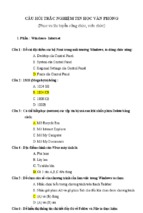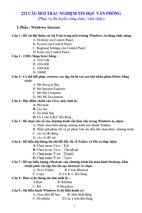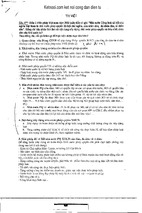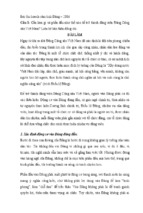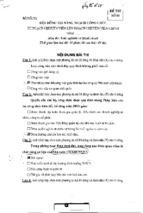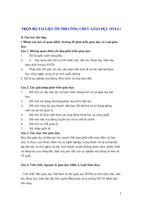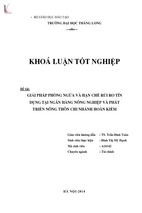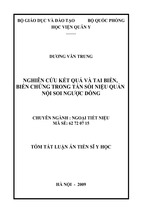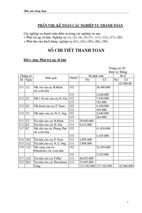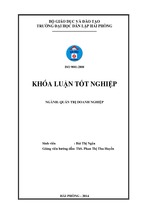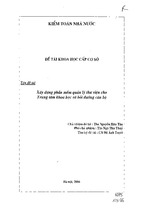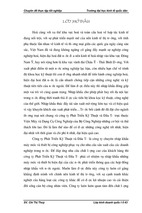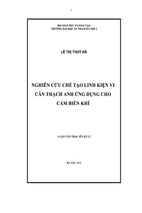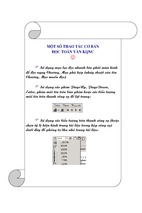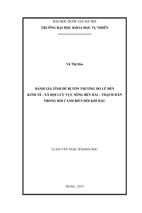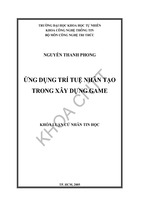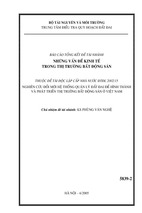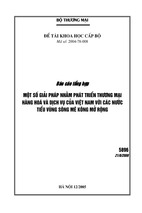HUA
ENGLISH for
Animal Science and
Aquaculture
Prepared by Nguyen Xuan Trach
Hanoi University of Agriculture
Introduction to the Course of English for
Animal Science and Aquaculture
This course of English is designed specifically for students of animal and
aquacultural sciences at Hanoi University of Agriculture (HUA). The objective of the
course is to help students to:
•
•
•
Get familiar with the key vocabulary usually used in animal and aquacultural
sciences and use them appropriately in scientific writing and oral communication.
Identify the most common grammar phenomena used in academic English for
effective reading comprehension and scientific writing.
Get used to the English writing styles in the literature of animal science
andaquaculture, and apply them appropriately in scientific writing.
The course consists of a series of lessons covering various topics, viz. Biology,
Animal Anatomy, Biochemistry, Physiology, Nutrition, Genetics and Breeding,
Reproduction, and Aquaculture. In each 5-teaching hour lesson, which is specified on a
topic, students will study some of the key vocabulary and grammar phenomena which
are usually used in academic English. Students will take part in discussion on some of
the important issues related to the topic of the lesson and compare their information and
ideas with fellow students. At the end of each lesson each student is required to write an
assignment using some of the new vocabulary and structures they have studied in the
lesson.
Hanoi, 15 March 2007
Course designer
Assoc. Prof. Dr. Nguyen Xuan Trach
2
Lesson 1: Biology
In this lesson you will study some of the key vocabulary we use when talking
about biology. You will discuss some of the important issues involved and compare your
information and ideas with those of your fellow students. At the end of the lesson you
will write a short account of the biodiversity in our country or region using some of the
new vocabulary and structures you have studied in this lesson.
After completing this unit you should be able to:
•
•
•
Define the key words introduced in this lesson and use them appropriately in
agricultural writing.
Use active and passive voices in sentences appropriately.
Discuss issues related to biodiversity in our country or region using the
vocabulary and grammar that you have learned.
Key Vocabulary
This section introduces the important words (key and technical vocabulary) that
will be used in the lesson. The instructor will give examples using each of the terms
properly during the lecture. You should be sure that you understand these terms before
you continue to the Reading.
accelerate (v) - làm tăng tốc
biodiversity -sự đa dạng sinh học
biology (n) - sinh học
breed (n) - giống (cây, con).
degrade (v) - phân giải, huỷ hoại
disappear (v) - biến mất
diversity (n) - sự đa dạng
domestication (n) - thuần hoá
evolution (n) - tiến hoá
extinct (adj.) - tiệt chủng
flourish (v) - nở rộ, phát triển tốt
gene - gen di truyền
genetic material - vật liệu di
truyền
habitat (n) - môi trường sống
identify (v) - xác định rõ (loài,
giống cây, con)
intensive agriculture - nông
nghiệp thâm canh
irreplaceable (adj.) - không thể
thay thế, cực kỳ quan trọng
organism - cơ thể sống
replace (v) - thay thế
selection - chọn lọc
skill (n) - kỹ năng
unprecedented (adj.) - chưa bao
giờ xảy ra
variety (n) - giống (cây trồng)
3
Grammar
Verb Tenses
The following reading introduces the Present Simple Tense. This is one of the six
most common verb tenses in English. Others include the Present Continuous tense, the
Future Simple tense, the Future with ‘going to’, the Past Simple tense, and the Present
Perfect tense. These tenses describe when something happens. All of the sentences in the
reading are in the ‘Present Simple Tense’. They describe things that happen every year,
always, every day, usually or sometimes.
The table below describes when to use each tense.
Tense
Example
When?
1. Present Simple
2. Present Continuous
3. Future Simple
4. Future with ‘going to’
5. Past Simple
6. Present Perfect
People eat rice
People are eating rice
People will eat rice
People are going to eat rice
People ate rice
People have eaten rice
every day
now
in the future
in the future
in the past
up to now
Present Simple
Used to describe things which happen every year, always, every day, usually or
sometimes.
Examples:
1. Most people in the Philippines eat rice.
2. She cooks rice everyday.
Present Continuous
Used to express an action in the present; something that is currently happening.
Examples:
1. They are eating rice.
2. He is cooking rice for dinner
Future Simple
Used to express the future.
Examples:
4
1. They will eat rice for breakfast.
2. I will cook more rice tonight.
Future ‘with going to’
Also used to express the future except you use the verb to be + going to. The meaning is
the same as the future simple.
Examples:
1. They are going to eat rice for dinner.
2. She is going to cook more rice tomorrow.
Past Simple
Used to express a completed action in the past.
Examples:
1. I ate rice for lunch.
2. They cooked rice.
Present Perfect
Used to show that an action was completed sometime before the present time. Used to
indicate that an action started in the past and continues to the present time.
Examples:
1. She has eaten rice every day of her life.
2. They have cooked rice over a fire for years.
Reading
Biodiversity
Around 1.4 - 1.75 million species of animals, insects, plants and other organisms
have been identified. However, scientists believe that there are over 13.5 million more
species which have not yet been identified. The diversity of life on earth is essential to
the survival of humanity, but this biological diversity is now being lost at an
unprecedented rate. Natural habitats are being destroyed, degraded and depleted,
resulting in the loss of countless wild species.
Traditional crop varieties and animal breeds are being replaced with new ones that
are more suited to modern agriculture. When natural diversity is lost, so is irreplaceable
genetic material, the essential building blocks of the plants and animals on which
agriculture depends. These plants and animals are the result of 3,000 million years of
natural evolution - and 12,000 years of domestication and selection.
5
Of the thousands of plant species that can be used for food, only 15-20 are of
major economic importance. In fact, only a handful supply the dietary energy needs of
most of the world's population. However, since 1900, about 75% of the genetic diversity
of agricultural crops has been lost. In India, there will soon be only 30-50 rice varieties
covering an area where 30,000 once flourished. Half of the animal breeds that existed in
Europe one hundred years ago are now extinct. One quarter of the livestock breeds in the
rest of the world are now at high risk of loss. The traditional knowledge and skills of
indigenous peoples - who selected, bred and cultivated such varieties over thousands of
years - are also disappearing. The loss of genetic resources has accelerated with the
spread of intensive agriculture and high-yielding crop varieties to large parts of the
developing world, replacing the traditional diversity of crops with monocultures. The
varieties being lost may contain genes that could be used to develop even more
productive varieties or to improve resistance to pests.
Discussion
Discuss the importance of biodiversity in our country. Use some of the language
and grammar you have learned in this lesson. The following questions may help you get
started.
- What is 'biodiversity'?
- Which countries do you think have a lot of biodiversity, and which countries
have little?
- Why is the preservation of biodiversity considered to be so important?
- How does the world's biodiversity today compare with the biodiversity that
existed a few hundred years ago?
- What are the main factors affecting biodiversity in today's world?
Assignment
Write a short description of biodiversity in your country (about 100 words). Try to
use at least 10 terms introduced in this lesson. Please try to use active and passive
sentences. Email the description to your instructor for comments and feedback.
The following questions may help you get started:
- How many different types of animals do you think there are in your country?
- What about insects / trees / birds / wild plant species?
- Which areas of your country have the greatest number of living things which
have not yet been touched by people?
6
- Do you think these areas should be left in their natural state or should they be
used by people? Why?
7
Lesson 2: Animal Anatomy
In this lesson you will study some of the key vocabulary we use when talking
about anatomy. You will discuss some of the important issues involved and compare your
information and ideas with those of your fellow students. At the end of the lesson you
will write a short account of anatomy using some of the new vocabulary and structures
you have studied in this lesson.
After completing this unit you should be able to:
•
•
•
Define the key words introduced in this lesson and use them appropriately in
scientific writing.
Use ………………….in sentences appropriately.
Discuss issues related to anatomy using the vocabulary and grammar that you
have learned.
Key Vocabulary
This section introduces the important words that will be used in the lesson. The
instructor will give examples using each of the terms properly during the lecture. You
should be sure that you understand these terms before you continue to the Reading.
Anatomy
muscular system
Greek
nervous system
head
reproductive system
chest
respiratory system
systems
skeletal system
circulatory system
comparative anatomy
digestive system
histology
morphology
endocrine system
Pathological anatomy
excretory system
organs
immune system
integumentary system
lymphatic system
medical
surgical
gynaecological
artistic
superficial
8
races
physical anthropology
Grammar
Active voice/Passive voice
When sentences are constructed in passive voice, they often do not have an 'agent'
- they do not tell us WHO or WHAT caused the action. This can be because WHO or
WHAT is not important, or because we already know WHO or WHAT.
In passive voice, the emphasis is on what is done, not on who or what did it.
Whereas, in the active voice, there is more emphasis on who is 'doing' the action.
Passive voice is very common in academic English, especially in writing.
Active and Passive Voice Constructions
Structure
Active Voice
subject + verb + object
Farmers feed cattle
Passive Voice
object
changes to + verb + 3rd
subject
'to be'
verb
Cattle are fed (by farmers)
Using the above illustration, please note that:
•
•
The '3rd verb' is often called the 'past participle'.
In passive voice we often leave out who/what does the action (in this case,
farmers) because we are more interested in what was done than who did it.
Furthermore / In addition / Moreover
Look at the followig sentences:
1. The seed oil repels insects and nematodes. Furthermore, it acts as an
antifeedent. (note the prefix: 'anti...' means 'opposed to', 'against', 'preventing')
2. Its strong trunk and branches help it withstand strong winds. Moreover, it resists
decay and insect attacks.
3. Neem oil can be used as a natural insectiide. In addition, neems makes a good
fertilizer.
Pelase note that:
9
•
•
•
'Furthermore', 'In addition', and 'Moreover' all mean 'also'
All 3 devices have exactly the same meaning and usage.
That they are used to start sentences, give extra information and are followed by a
comma (,).
Reading
Branches of Anatomy
Anatomy (from the Greek ἀνατομία anatomia, from ἀνατέμνειν anatemnein, to
cut up, cut open), is the branch of biology that deals with the structure and organization
of living things. It can be divided into animal anatomy (zootomy) and plant anatomy
(phytonomy). Furthermore, anatomy can be covered either regionally or systemically,
that is, studying anatomy by bodily regions such as the head and chest for the former, or
studying by specific systems. For the latter, the major body systems include circulatory
system, digestive system, endocrine system, excretory system, immune system,
integumentary system, lymphatic system, muscular system, nervous system, reproductive
system, respiratory system, skeletal system.
Major branches of anatomy include comparative anatomy, histology, and human
anatomy. Animal anatomy may include the study of the structure of different animals,
when it is called comparative anatomy or animal morphology, or it may be limited to one
animal only, in which case it is spoken of as special anatomy. Pathological anatomy (or
morbid anatomy) is the study of diseased organs, while sections of normal anatomy,
applied to various purposes, receive special names such as medical, surgical,
gynaecological, artistic and superficial anatomy. The comparison of the anatomy of
different races of humans is part of the science of physical anthropology or
anthropological anatomy.
Discussion
Discuss the importance of anatomy in animal and veterinary sciences. Use some
of the language and grammar you have learned in this lesson. The following questions
may help you get started.
Assignment
Write a short account of anatomy as a subject in the training program at your faculty
(about 100 words). Try to use at least 10 terms introduced in this lesson. Please try to use
…………... Email the description to your instructor for comments and feedback.
10
11
12
Lesson 3: Biochemistry
In this lesson you will study some of the key vocabulary we use when talking
about biochemistry. You will discuss some of the important issues involved and compare
your information and ideas with those of your fellow students. At the end of the lesson
you will write a short account of the biochemistry using some of the new vocabulary and
structures you have studied in this lesson.
After completing this unit you should be able to:
•
•
•
Define the key words introduced in this lesson and use them appropriately in
scientific writing.
Use relative pronouns in sentences appropriately.
Discuss issues related to biochemistry using the vocabulary and grammar that you
have learned.
Key Vocabulary
This section introduces the important words that will be used in the lesson. The
instructor will give examples using each of the terms properly during the lecture. You
should be sure that you understand these terms before you continue to the Reading.
advance (n) tiến bộ mới
extract (v) chiết suất, chắt lọc
aging (n) sự lão hoá
facet (n) khía cạnh
biochemistry (n) hoá sinh
function (n) chức năng
cell (n) tế bào
genetics (n) di truyền học
chemistry )n) hoá học
heredity (n) sự di truyền
component (n) thành phần cấu tạo
impact (n) tác động
death (n) sự chết
information (n) thông tin, tín hiệu
due in large part to phần lớn nhờ vào
interaction (n) sự tương tác
ecology (n) sinh thái
laboratory (n) phòng thí nghiệm
energy (n) năng lượng
matter (n) vật chất
experimental (adj.) thuộc thí nghiệm
medicine (n) y học
expression (n) sự biểu hiện
metabolism (n) sự trao đổi chất
13
molecular (adj.) thuộc về phân tử
science (n) ngành khoa học
nutrition (n) dinh dưỡng
structure (n) cấu trúc
occur (v) xảy ra
substance (n) chất, cơ chất
reaction (n) phản ứng
surroundings (n) môi trường xung
quanh
reproduction (n) sự sinh sản, tái tạo
tissue (n) mô bào
research (n) sự nghiên cứu
Grammar
Reading
The Goals of Biochemistry
Biochemistry is a science which seeks to describe the structure, organization, and
functions of living matter in molecular terms. What are the chemical structures of the
components of living matter? How do the interactions of these components give rise to
organized super-molecular structures, cells, multi-cellular tissues, and organisms? How
does living matter extract energy from its surroundings in order to remain alive? How
does an organism store and transmit the information it needs to grow and to reproduce
itself accurately? What chemical changes accompany the reproduction, aging, and death
of cells and organisms? How are chemical reactions controlled inside living cells? These
are the kinds of questions being asked by biochemists; the research for the answer is the
study of the chemistry of life.
Biochemistry can be divided into three principal areas: (1) the structural
chemistry of the components of living matter and the relationship of biological function
to chemical structure; (2) metabolism, the totality of chemical reactions that occur in
living matter; and (3) the chemistry of processes and substances that store and transmit
biological information. The third area is also the province of molecular genetics, a field
that seeks to understand heredity and the expression of genetic information in molecular
terms.
Biochemistry is an experimental science, and the remarkable recent advances in
biochemistry are due in large part to the development of powerful new laboratory
techniques. Biochemistry has had major impacts on medicine, agriculture, nutrition,
ecology, and many other facets of life.
14
Discussion
Discuss the aim of biochemistry and its importance in animal and veterinary
sciences. Use some of the language and grammar you have learned in this lesson. The
following questions may help you get started.
- What is 'biochemistry'?
- What is the aim of biochemistry?
- What are the common questions being asked by biochemists?
- What are the main areas of biochemistry?
Assignment
Write a short account of biochemistry as a subject in the training program at your
faculty (about 100 words). You may also use the drawing below for writing your assay.
Try to use at least 10 terms introduced in this lesson. Please try to use relative pronouns.
Email your work to your instructor for comments and feedback.
15
Lesson 4: Animal Physiology
In this lesson you will study some of the key vocabulary we use when talking
about animal physiology. You will discuss some of the important issues involved and
compare your information and ideas with those of your fellow students. At the end of the
lesson you will write a short account of animal physiology using some of the new
vocabulary and structures you have studied in this lesson.
After completing this unit you should be able to:
•
•
•
Define the key words introduced in this lesson and use them appropriately in
scientific writing.
Use ………………….in sentences appropriately.
Discuss issues related to animal physiology using the vocabulary and grammar
that you have learned.
Key Vocabulary
This section introduces the important words that will be used in the lesson. The
instructor will give examples using each of the terms properly during the lecture. You
should be sure that you understand these terms before you continue to the Reading.
Grammar
Suffixes and Prefixes
A 'suffix' is a letter or a group of letters added at the end of a word to make another word.
Example:
'...dy' added to the noun mud to make the adjective 'muddy'
A 'prefix' is a letter or group of letters placed in front of a word to make another word.
Example:
'un..' added to important to make 'unimportant'
Look at the following sentences:
The hard wood is brownish.
Young branches are yellowish.
16
same as:
The wood is quite brown, but not totally.
The color of the young branches is similar to yellow.
Please note that on the first two sentences, the suffix '...ish':
•
•
indicates 'similar to', 'nearly', 'rather', 'fairly', 'somewhat' or 'quite'
can be used to qualify many adjectives, especially colors.
More examples:
In parts of the Philippines, the most important use of neem is for reforestation.
Please note the difference between:
deforestation - the destruction or degradation of forests
(The prefix 'de...' means 'opposite' or negative of)
reforestation - planting trees in an area where the forest has been destroyed or degraded
(The preifx 're...' means 'again')
afforestation - planting trees to make a new forest in an area which did not have forests
in the past
Reading
Animal Physiology
Physiology (in Greek physis = nature and logos = word) is the study of the
mechanical, physical, and biochemical functions of living organisms.
Physiology has traditionally been divided into plant physiology and animal
physiology but the principles of physiology are universal, no matter what particular
organism is being studied. For example, what is learned about the physiology of yeast
cells can also apply to human cells.
Animal physiology is the study of how animals’ bodies function in their
environment. An understanding of the physiological problems animals face and how they
solve those problems can be achieved only in an evolutionary context. Knowledge of
certain aspects of the natural history, morphology, behavior, and environment of an
animal is necessary to fully appreciate the importance of its physiological mechanisms.
17
The study of animal physiology includes topics such as: gas exchange, feeding
and digestion, circulation, metabolic rate, water and solute regulation, temperature
regulation, excretion of wastes, and movement. The comparative approach can help us to
develop a general evolutionary framework in which to address physiological problems.
By comparing how different animals solve related problems in various environments, we
can begin to gain insight into physiological principles that apply across levels of
organisms and environments.
Discussion
Discuss the importance of the study of animal physiology in animal and
veterinary sciences. Use some of the language and grammar you have learned in this
lesson. The following questions may help you get started.
- What is physiology?
- What is animal physiology?
- What are the main topics of the study of animal physiology?
Assignment
Write a short assay on a topic of animal physiology (about 100 words). Try to use
at least 10 terms introduced in this lesson. You may describe the milk letdown reflex
based on the drawing given below. Email the assignment to your instructor for comments
and feedback.
18
Lesson 5: Animal Nutrition
In this lesson you will study some of the key vocabulary we use when talking
about animal nutrition. You will discuss some of the important issues involved and
compare your information and ideas with those of your fellow students. At the end of the
lesson you will write an assay on a topic of animal nutrition using some of the new
vocabulary and structures you have studied in this lesson.
After completing this unit you should be able to:
•
•
•
Define the key words introduced in this lesson and use them appropriately in
scientific writing.
Use infinitives and gerunds in sentences appropriately.
Discuss issues related to animal nutrition using the vocabulary and grammar that
you have learned.
Key Vocabulary
This section introduces the important words that will be used in the lesson. The
instructor will give examples using each of the terms properly during the lecture. You
should be sure that you understand these terms before you continue to the Reading.
Grammar
Verbs followed by infinitive
Verbs followed by gerund
Some verbs can be followed by other verbs.
Examples:
1. I hope to arrive on Wednesday.
2. Do you enjoy studying English?
It is important to know:
•
•
•
which verbs are always followed by the infinitive (to arrive)
which verbs are always followed by the gerund (studying)
which verbs can be followed by the infinitive or the gerund
These verbs are always followed by the infinitive:
19
agree
ask
attempt
claim
decide
demand
desire
fail
forget
hesitate
hope
intend
learn
need
offer
plan
prepare
pretend
refuse
seem
strive
tend
try
want
wish
Examples:
1. The Rockafeller and Ford Foundations decided to use semi-dwarf varieties.
2. Modern varieties tend to be shorter than traditional ones.
3. Plant breeders strive to keep ahead of the changing environment.
These verbs must always be followed by the gerund:
admit
appreciate
avoid
can't help
consider
delay
deny
encourage
enjoy
finish
mind
miss
postpone
practice
quit
recall
regret
report
resent
resist
resume
risk
suggest
support
promote
Examples:
1. The government delayed introducing the new variety as it wanted to conduct
more trials.
2. Farmers who use high levels of pesticide risk being exposed to a variety of
ailments.
3. We suggest doing this a different way.
These verbs can be followed by either the infinitive or the gerund:
begin
can't stand
continue
hate
like
love
prefer
start
Examples:
Farmers in that area started to use improve varieties.
Farmers in that area started using improved varieties.
We should continue to study this problem.
We should continue studying this problem.
Many consumers prefer to buy familiar rice types.
Many consumers prefer buying familiar rice types.
20
- Xem thêm -


